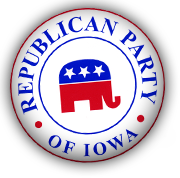Iowa Democrats Bracing for Bloodbath in 2010 State House Elections
Democrats fail to field a candidate in 25 of 100 Iowa House contests – most by any major party since the lower chamber became a 100-member body in 1970; GOP fields its most candidates since 1980
This is the first in a series of Smart Politics reports on state legislative races leading up to the 2010 general election.

A Smart Politics analysis of over 2,000 elections to the Iowa State House since 1970 finds the state’s Democratic Party has set a record in 2010 for the largest number of districts in which a major political party has failed to field a House candidate since the lower chamber became a 100-seat body 40 years ago.
Partisan control of many state legislative chambers across the country are expected to flip to the Republicans after the 2010 election cycle, with the Iowa House of Representatives near the top of that list.
Iowa Democrats could not find candidates to run in a full quarter of the 100 House Districts across the state: in House Districts #3 (Plymouth County), 4 (Sioux), 5 (O’Brien), 6 (Dickinson), 12 (Hancock), 17 (Butler), 32 (Dubuque), 35 (Linn), 36 (Linn), 39 (Benton), 40 (Tama), 50 (Webster), 53 (Cherokee), 55 (Crawford), 56 (Harrison), 57 (Cass), 58 (Adair), 69 (Polk), 70 (Polk), 82 (Scott), 83 (Clinton), 87 (Louisa), 96 (Ringgold), 97 (Page), and 98 (Pottawattamie).
The inability of Democrats to come anywhere close to fielding a full slate of candidates this November comes just two years after filling the ballot in 94 of 100 House district contests in 2008 – their best showing since 1976 when the Democratic Party also ran 94 candidates.
The 19-district jump from 2008 (6) to 2010 (25) for the number of House districts in which Democrats are waving the white flag is also a Hawkeye State record.
The previous worst showing by the Democratic Party in fielding House candidates in Iowa came, perhaps not coincidentally, in 1994, when 24 districts were left fallow in that year’s House races.
Republicans took advantage of the thin Democratic field in 1994, transforming their narrow two-seat 51-49 seat advantage coming out of the 1992 election into a decisive 64-36 margin after 1994.
It would take Democrats in Iowa 12 years before eventually overcoming that 28-seat deficit, finally winning back the House of Representatives in 2006.
The 25 seats in the lower chamber Iowa Democrats are yielding to the Republican Party without a fight in 2010 are twice the average number of districts the Party failed to contest from 1970 through 2008.
During this 20-cycle span, Democrats had not fielded a candidate in 249 races, or just 12.5 districts per cycle.

This marks the GOP’s best showing since the Reagan Revolution of 1980, when Iowa Republicans ran candidates in 97 House races.
This year, the Iowa GOP only failed to field candidates in House Districts #22 (Black Hawk County), 30 (Johnson), 38 (Linn), 62 (Polk), 66 (Polk), 77 (Johnson), 78 (Johnson), and 85 (Scott).
The 92-candidate GOP field also ends a 14-cycle, 28-year run in which Republicans did not get candidates onto the ballot in 10 or more districts.
From 1982 through 2008, Iowa Republicans left 231 seats unchallenged, or an average of 16.5 districts per cycle.
Iowa State House Elections Without a Major Party General Election Candidate, 1970-2010
|
Year
|
No Dem
|
No GOP
|
Total
|
|
2010
|
25
|
8
|
33
|
|
2008
|
6
|
16
|
22
|
|
2006
|
18
|
23
|
41
|
|
2004
|
15
|
23
|
38
|
|
2002
|
20
|
18
|
38
|
|
2000
|
16
|
20
|
36
|
|
1998
|
19
|
19
|
38
|
|
1996
|
13
|
11
|
24
|
|
1994
|
24
|
18
|
42
|
|
1992
|
13
|
15
|
28
|
|
1990
|
15
|
17
|
32
|
|
1988
|
10
|
11
|
21
|
|
1986
|
21
|
14
|
35
|
|
1984
|
11
|
16
|
27
|
|
1982
|
7
|
10
|
17
|
|
1980
|
11
|
3
|
14
|
|
1978
|
16
|
7
|
23
|
|
1976
|
6
|
4
|
10
|
|
1974
|
0
|
7
|
7
|
|
1972
|
1
|
3
|
4
|
|
1970*
|
7
|
2
|
9
|
* In 1970, the Iowa House was reduced from a 124 to a 100 seat legislative body. Data compiled from the Iowa Official Register by Smart Politics.
In theory, the failure of the Democrats, and the success of Republicans, in fielding candidates this November does not automatically mean the 12-seat Democratic advantage will be erased.
But, in reality, it does.
· During the last two national Republican waves, 1980 and 1994, Iowa Democrats won only 47.2 and 47.4 percent of the districts in which they ran candidates. A 47 percent success rate for Democrats across the 75 districts they fielded candidates in 2010 would reduce their number of seats from 56 to just 35 in the lower chamber.
· Taking a longer view, Iowa Democrats have won 55 percent of districts in which they ran a candidate from 1970 through 2008. That would put the Democrats at a 15-seat loss down to 41 districts.
· But perhaps the most sobering news for House Democrats is this: During the last 20 election cycles, Iowa Democrats have won a large enough percentage of seats in which they ran a candidate in just three election cycles that would allow them to retain majority status in 2010 (66 percent): 1984 (67.4 percent), 1986 (73.4 percent), and 1988 (67.8 percent).
In other words, even if Democrats win 65 percent of districts in which they fielded a candidate this November, they will still net just 49 seats and become the minority party once again in the Iowa House of Representatives.
Iowa House Seats Contested and Won by Democratic Party, 1970-2010
|
Year
|
Contested
|
Won
|
% Won
|
|
2010*
|
75
|
?
|
?
|
|
2008
|
94
|
57
|
60.6
|
|
2006
|
82
|
54
|
65.9
|
|
2004
|
85
|
49
|
57.6
|
|
2002
|
80
|
46
|
57.5
|
|
2000
|
84
|
44
|
52.4
|
|
1998
|
81
|
44
|
54.3
|
|
1996
|
87
|
46
|
52.9
|
|
1994
|
76
|
36
|
47.4
|
|
1992
|
87
|
49
|
56.3
|
|
1990
|
85
|
55
|
64.7
|
|
1988
|
90
|
61
|
67.8
|
|
1986
|
79
|
58
|
73.4
|
|
1984
|
89
|
60
|
67.4
|
|
1982
|
93
|
60
|
64.5
|
|
1980
|
89
|
42
|
47.2
|
|
1978
|
84
|
44
|
52.4
|
|
1976
|
94
|
59
|
62.8
|
|
1974
|
100
|
61
|
61.0
|
|
1972
|
99
|
44
|
44.4
|
|
1970*
|
93
|
36
|
38.7
|
|
Total
|
1,826
|
1,005
|
55.0
|
* Democrats will need to win 66 percent of House districts they are contesting in 2010 to retain control of the Iowa House. ** In 1970, the Iowa House was reduced from a 124 to a 100 seat legislative body. Data compiled from the Iowa Official Register by Smart Politics.
Follow Smart Politics on Twitter.

The Iowa Democratic Party’s GOTV is light-years ahead of where it was in 1994, and despite the bad overall climate, there are a few House districts Democrats are well-positioned to pick up (51, 74, 99). There is a decent chance of holding the Iowa House, and even if Republicans win a majority, it’s unlikely to be comparable to their post-1994 majority.
evidently the dems can see the writing on the wall…in local races where assets are limited, very few people will take that kind of financial risk….im rather excited by what is happening…the people are “going to throw the bums out” finally….all of the spending, the high taxes, earmarks, nonsense, unread 2000 pieces of legislation and failure toa adhere to the constitution is coming to an end…..and if the people who we elect this time dont “walk the walk”, we will vote them out as well.